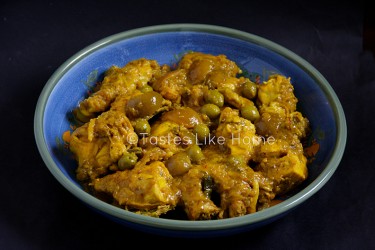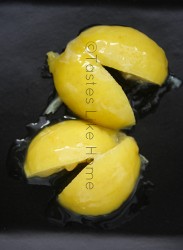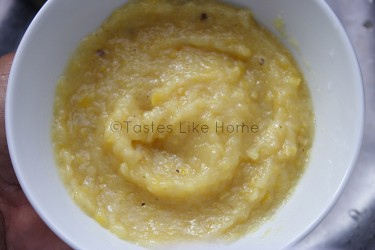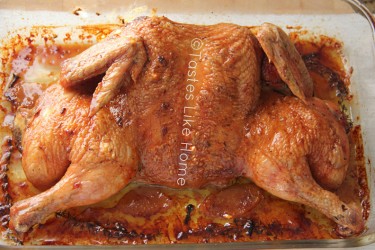Hi Everyone, It’s been 4 weeks to the day since I first wrote to you about preserved limes. At that time I asked you to preserve some limes so that we could meet back here and discuss how to use this ingredient that you now have stocked in your refrigerator.
A quick re-cap: preserved limes are limes that are quartered, packed with salt and cured in their own juices for 4 weeks. They are an essential ingredient in North African and Middle Eastern cuisines. While the ingredient brings a taste of Morocco to our tables, especially when we use it to make tagine-like stews, there are very many other dishes and ingredients in our cuisine that can use preserved limes.
I’m holding up my end of the deal – to tell you how to use the preserved limes. Once preserved, store the jars/bottles in the refrigerator where the preserved limes will last for a very long time. Access the limes using a wooden, plastic, ceramic fork or spoon. It is better not to use a metal fork or spoon because the acidity of the preserved limes could tarnish your metal. Remove the limes and follow the instructions of your recipe – it will indicate whether or not to rinse the limes, chop, and puree or use whole, when and how to add them to the dish.
 Preserved limes bring a citrus flavour to anything to which they are added and in some cases, they are there to liven up a dish, letting other flavours and ingredients shine through. In other words, preserved limes can play a front and centre role as well as backup. When added early in a dish preserved limes mingle with other flavour ingredients – spices, herbs – resulting in a taste that something very savoury with an umami-like quality that you can’t quite put your hand on. On the other hand, when added at the end of a dish, it is lip-smacking good and easily discernable.
Preserved limes bring a citrus flavour to anything to which they are added and in some cases, they are there to liven up a dish, letting other flavours and ingredients shine through. In other words, preserved limes can play a front and centre role as well as backup. When added early in a dish preserved limes mingle with other flavour ingredients – spices, herbs – resulting in a taste that something very savoury with an umami-like quality that you can’t quite put your hand on. On the other hand, when added at the end of a dish, it is lip-smacking good and easily discernable.
The entire lime is used when preserved – the rind and pulp – however, it is the skin/rind that is most often used or called for in a recipe. Using the pulp brings a more intense citrus flavour. Always be guided by the recipe you are using until you become comfortable and confident using the ingredient. As soon as you get to understand the ingredient and how it works, you will find multiple uses for it and work with it deftly. My main advice is to always taste as you go along. Each of us responds differently to taste, some of you may like just a hint of the lime flavour while others would like it more pronounced.

Another piece of advice I would give is this, remember that the preserved limes are briny/salty so you will need to adjust by adding less salt to the foods that you’re planning to add preserved limes, especially if you are using the pulp.
Based on the advice of a Moroccan chef, I store my preserved limes in two ways – whole in their brine until ready to use and pureed. I find both ways extremely useful. The whole preserved limes work better when making certain things like roasts and stews. The pureed preserved limes can be added quickly and easily to many things. I find myself using the pureed version much more often for everyday dishes. I highly recommend that you puree and bottle some of the limes you preserved. If you made 2 bottles – keep 1 whole and puree the other.
To puree, remove the limes from the brine and shake off the excess (brine), using a fork, remove the seeds. Add the whole limes – pulp and rind – to a food processor and pulse until a fine paste, it does not have to be smooth. Store the pureed limes in the same bottle in which it was cured, cover tight and refrigerate.
Let’s get cooking! Here are some ways to use your preserved limes.


Stews like the Moroccan-style tagines: stews cooked in clay pots made with various meats cooked with fruits like dried apricots, figs, dates, prunes, raisins, olives, nuts, herbs, and spices. When making this North African style of stew the preserved limes are added whole or quartered towards the end of the cooking. Only the rind is used. I’ve included a recipe in the style of chicken tagine. The use to turmeric or saffron immediately makes you think of curry.
Roasts – particularly poultry, such as chicken pair well with preserved limes. The flesh and rind of the limes are used. The bird is rubbed all over, inside and out for seasoning then sprinkled with black pepper, or ground cumin or any all-purpose seasoning. Very little extra salt is added. The rind is tucked under the skin of the breast on both sides, between the thighs and in the cavity. The pan drippings from the roast have marmite-like qualities with enhanced notes of citrus. I have included a recipe for roast chicken with preserved limes.
Roast potatoes – mix some of the pureed preserved limes with oil and toss with par-cooked potatoes and roast.
Add some of the pureed version to mayonnaise to make citrus mayo or to aioli for a garlic-lime aioli. Stir in to dips, spreads or salsas.
When grinding coconut for coconut choka, grind a piece of the rind and if you like some of the pulp to give that little tang to the choka. Rinse off the lime to remove excess brine before using.
Mix in the pureed preserved limes to potato choka, baigan (eggplant) choka and tomato choka. Liven up hummus (chickpea/channa dip) with preserved limes. If using the rind, rinse off to remove excess brine.
Mince the rind very finely and add to buljol (picked salt fish, smoked fish, smoked herring). Rinse off the lime to remove excess brine before using.
Mix the pureed limes with oil, mustard and black pepper to make vinaigrettes or other salad dressings.

Stir in pureed limes just as you are done chunkay/tempering dhal.
Add the rind just before fish and other seafood curry that you are making with a sauce/gravy are done cooking. Works the same way with curried chicken. Rinse off the lime to remove excess brine before using.
Toss hot, freshly cooked pasta with pureed limes, fried garlic and high quality olive oil for an excellent bowl of light pasta.
Stir in to lentil and vegetable-based soups such as pumpkin. Add pureed or 1 – 2 pieces of rind. If using the rind, rinse to remove the excess brine.
Toss cucumbers with pureed limes along with freshly ground black pepper for a cucumber salad. Do the same with sliced red onions for a quick pickle.
Shake off the excess brine, remove the seeds and blend with pepper to make a citrus flavoured pepper sauce.
Mix the pureed limes with room temperature unsalted butter to make a compound butter that you use to cook to finish sauces, spread on bread and lighty toast for sandwiches or plop on top of steamed fish, shrimp or melt over steaks.
I’ve got to stop here now. If you need more ideas on how to use your preserved limes, inbox me: Cynthia@tasteslikehome.org
Cynthia
Moroccan-style Chicken with Preserved Limes & Olives
(Heavily adapted from Christine Benlafquih)
To try to create the tagine-like conditions for making this dish, use a Dutch oven or a heavy-bottomed pot with a tight lid.
INGREDIENTS
1 large whole chicken, cut into 10 pieces
¼ cup vegetable oil
½ cup chopped fresh cilantro (plus extra to garnish, optional)
½ cup chopped fresh parsley
3 cloves garlic, grated to a paste
2 teaspoons grated fresh ginger
½ teaspoon ground turmeric
½ teaspoon fine table salt
Minced hot pepper to taste
½ teaspoon saffron threads, crumbled, divided in half
1 pound of onions, peeled and sliced thinly
4 tablespoons warm water
1 heaped cup pitted green olives
1 whole preserved lime, rinsed, quartered and the seeds removed
DIRECTIONS
Mix together the following ingredients in a large bowl: chicken, oil, cilantro, parsley, garlic, ginger, turmeric, salt, pepper and half of the saffron. Toss well to coat the chicken with the aromatics.
Scatter the onions at the bottom of the pot/Dutch oven and transfer the seasoned chicken and any liquid it is sprung to the pot resting it on top of the onions. Cover the pot tightly with the lid and place on medium heat. Remove the cover after 15 minutes on the heat and give the pot a stir. Re-cover the pot and let the chicken cook until it’s done. Keep checking every 10 – 15 minutes. Reduce the heat to avoid the meat scorching. It should take about 1 hour to cook the chicken. Do not add any water, the chicken is meant to braise (cook in its own juices), and with steam.
When the chicken is done cooking, remove it from the pot, shaking off the excess liquid and any onions stuck on it. Cover and set aside to keep warm.
Continue to cook the onion mixture and sauce, stirring occasionally until the liquid evaporates and the onions form a blended mass and separates from the oil. This stage takes patience and time so do not turn up the heat to hurry it along. The cooked onions are transformed and melted. Think of the transformation onions when caramelized.
When the onions are done, and the heat sill on low, add the olives, preserved lime, the rest of the saffron and 4 tablespoons of water. Simmer gently for 6 – 8 minutes.
Add the chicken back to the pot that now has in the olives and preserved limes, give a gently toss to coat the chicken, cover the pot and heat through.
To serve, arrange the chicken on a platter and pour the onion sauce over the top and sides. Arrange the olive and preserved lemons on top of the chicken. Serve with white rice, couscous or artisan-style crusty bread. This goes well with sadha roti.
NOTES
If your preserved limes are small, use 2 instead of 1.
Remove the pulp and only use the rind if you do not want the chicken too limy.
The salt for seasoning the chicken seems a little but remember that there will be salt from the preserved limes and the cured olives.
Roast Chicken with Preserved Limes & Thyme
INGREDIENTS
1 large whole chicken rinsed and pat dry
2 whole preserved limes (do not rinse)
Several sprigs fresh thyme
½ teaspoon freshly ground black pepper
¼ teaspoon paprika
¼ teaspoon fine table salt
1 tablespoon vegetable oil
½ cup vegetable stock
DIRECTIONS
Preheat oven to 350 degrees F.
Rub a baking dish with the oil and set aside.
Leave the chicken whole or butterfly it – remove the spine, and then press down hard to break the breast bone and flatten the chicken.
Remove and discard the seeds from the preserved limes. Separate the pulp from the rinds, tear the rinds into their pre-cut quarters (you should get 8 pieces).
Rub the pulp all over the chicken, including under the skin. If you are leaving your chicken whole, rub inside of the cavity too.
Place 2 rinds of the preserved limes under the skin of the breast 1 piece on either side, and another 2 pieces, one on either side between the thighs.
Mix together the black pepper, paprika and salt, and sprinkle all over the chicken.
Assemble the thyme springs in an even layer in the baking dish and place 2 pieces of the rind on top of the thyme. Rest the chicken on top of the bed of thyme. If using the chicken whole, insert several of the sprigs and 2 pieces of lime into the cavity of the chicken.
Scatter the remaining thyme around the baking dish along with the remaining 2 pieces of lime.
Transfer the dish to the oven and cook for 90 minutes or until the juices run clear from a knife inserted into thighs. You will need to cook the chicken longer if you leave it whole and depending on the size of your bird.
Baste the bird during the final half hour of cooking.
When the chicken is done, remove it from the oven and cover with foil. Let rest for 15 – 20 minutes.
Remove the foil and pour off the drippings from the chicken into a sauce pot and remove some of the fat. Scrape off any stuck on bits at the bottom of the baking dish and add it to the drippings. Pour the stock into the sauce pot and place on medium heat, stir to mix and bring to a boil then simmer for 3 – 5 minutes.
Carve/cut up the chicken and ladle the sauce over it or serve the sauce on the side.









